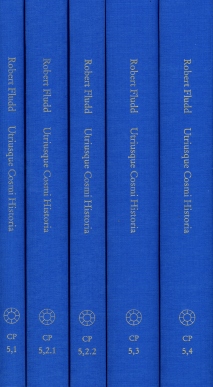Robert Fludd: Utriusque Cosmi Historia
Facsimile edition of the first edition (Oppenheim/Frankfurt, Johann Theodor de Bry, 1617–1621). Various tables depicting the original copperplate engravings as well as two fold-outs.
Nur Gesamtabnahme
Links / Downloads
Robert Fludd’s (1574–1637) ›Utriusque Cosmi Historia‹ is a key work of mystical »Naturphilosophie« in the early modern era. It is an encyclopedia of all those theories excluded from the scientific canon due to their alleged superstition and irrationality. Fludd – medical scientist, astrologist, Kabbalist, mathematician and »Naturphilosoph« – develops a cosmology that depicts the influence of the stars on world events, as well as illustrating and describing in detail all the man-made arts and technologies during this period, which are explained in analogy with their celestial archetypes. – The many illustrations make this book the most beautiful encyclopedia of the early modern era.
Volume 1: De Macrocosmi structurae, ejusque creaturarum originis historia in libros VII divisa. Oppenheim 1617.
This volume presents the history of creation and illustrates it with pictures, beginning with the creation of heaven and earth, followed by the emergence of plants, animals and, finally, man.
Volumes 2,1-2: De naturae simia seu Technica macrocosmi historia. Frankfurt 1624
This volume contains an extensive and visual depiction of the human arts, covering mathematics, music, optics, painting, military technology, the study of automata, meteorology and astrology.
Volume 3: De supernaturali praeternaturali et contranaturali microcosmi historia. [Oppenheim 1619]
The third volume introduces Fludd’s metaphysics and physics. His metaphysics is an outline of a speculative arithmetic based on Nicholas of Cusa’s ideas; his physics illustrates in words and pictures the relation of microcosm and macrocosm and can thus be regarded as an overall view of Renaissance medicine and anthropology.
Volume 4: De Theosophico, Cabalistico et Physiologico utriusque mundi discursu. Frankfurt 1621. Anatomiae Amphitheatrum. Frankfurt 1623
In the fourth volume, Fludd presents the Kabbalistic and Pythagorean basics of his encyclopedic theory. This work is the first major overall depiction of the Christian Kabbalah in the early modern period.
Reviews
»Stöbert man in den fünf Bänden, die Herausgeber Wilhelm Schmidt-Biggemann mit glänzend klaren Erläuterungen versehen hat, so erlebt man ein Feuerwerk an Untersuchungen, Ideen, Spekulationen. Die Entstehung der Elemente, Verknüpfungen von Makro-und Mikrokosmos und heute ziemlich wild wirkende theologische Überlegungen fügen sich zum Gesamtkunstwerk. [...] Dem in Stuttgart-Bad Cannstatt ansässigen Verlag Frommann-Holzboog ist eine epochale editorische Großtat gelungen, die durchaus ihren Preis hat. Aber man kann die ›Geschichte beider Kosmen‹ durchaus als doppelte Investition ansehen: einmal als ziemlich langen und wichtigen Begleiter seiner Lebens- und Lesezeit und als derzeit wohl exklusivstes Coffee Table Book.«
»Die ganze Welt in einem Buch: Die wichtigste Enzyklopädie der Frühen Neuzeit, Robert Fludds ›Geschichte beider Kosmen‹, ist in einer vollständigen und herausragend edierten Faksimile-Ausgabe erschienen. Das ist eine Sensation.«
"Insgesamt aber wird mit Fludds Enzyklopädie ein Werk wieder zugänglich gemacht, das wie kaum ein anderes die Pracht und Fülle und Verschrobenheit all dessen enthält,was die moderne Wissenschaft und Philosophie hinter sich gelassen hat.
All volumes
- Sefer Jezirah – available
- Lullus: Opera – available
- Weigel: Werke – continued
- Schmidlin: Pictura docens – available
- Fludd: Utriusque Cosmi Historia – available
- Khunrath: Amphitheatrum Sapientiae Aeternae – Schauplatz der ewigen allein wahren Weisheit – available
- Das Corpus Hermeticum Deutsch – available
- Brecht: J. V. Andreae und Herzog August zu Braunschweig-Lüneburg – available
- Pring-Mill: Der Mikrokosmos Ramon Llulls – available
- Schmidt-Biggemann: Geschichte der christlichen Kabbala – available
- Ricius: Schriften zur christlichen Kabbala – continued
- Law: Das ›Corpus Hermeticum‹ – Wirkungsgeschichte: Transzendenz, Immanenz, Ethik – continued
- Subject Areas
- New Publications
- ---
- Critical Editions
- Collected Works
- Series
- Arbeiten und Editionen zur Mittleren Deutschen Literatur
- Aufklärung und Revolution
- Böhme-Forschungen
- Bibliothek 1800
- Clavis Pansophiae
- Collegium Philosophicum
- Commentaria in Aristotelem Graeca
- Doctrina et Pietas
- Editionen zur Frühen Neuzeit
- Elea
- Europäische Literatur der Frühen Neuzeit
- exempla aesthetica
- Forschungen und Materialien zur Universitätsgeschichte
- Forschungen und Materialien zur deutschen Aufklärung
- Freidenker der europäischen Aufklärung
- Freud heute
- frommann-holzboog Studientexte
- Fundamenta Historica
- Grammatica Speculativa
- Grammatica Universalis
- Kultur und Gesellschaft
- legenda
- Judith Le Soldat heute
- Medizin und Philosophie
- Melanchthon-Schriften der Stadt Bretten
- Mystik in Geschichte und Gegenwart
- Natur und Philosophie
- Neuzeit im Aufbau
- Philosophie interkulturell
- Philosophische Clandestina der deutschen Aufklärung
- Der Platonismus in der Antike
- Politische Philosophie und Rechtstheorie des Mittelalters und der Neuzeit
- problemata
- Psychoanalysis International
- Quaestiones
- Schellingiana
- Specula
- Spekulation und Erfahrung
- Supplementum Platonicum
- Volksaufklärung
- Werkstatt Bionik und Evolutionstechnik
- Bibliographies and Reference Books
- Allgemeine Zeitschrift für Philosophie
- AZP Beihefte
- Jahrbuch der Psychoanalyse
- JP Beihefte
- Steiner Studies
- Open-Access
- Single volumes
- eBooks
- Special Offers
- ---
- Authors
- Publishing house
- Links / Partner
- Paths to Philosophy
